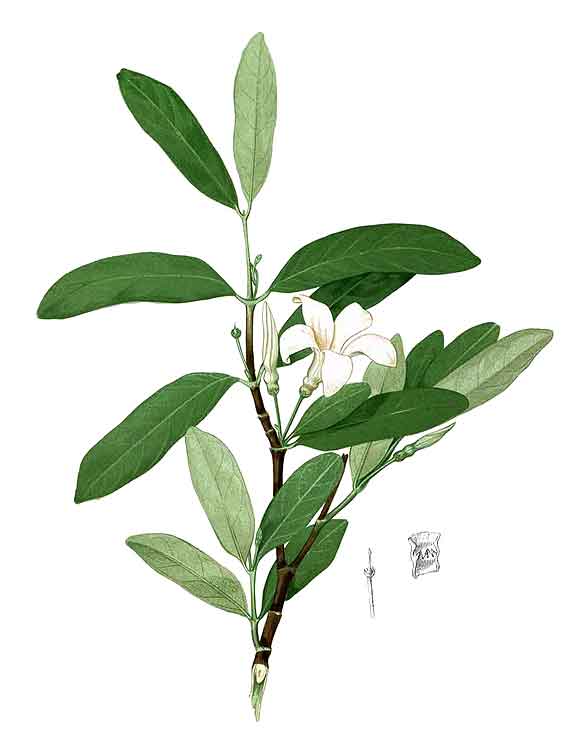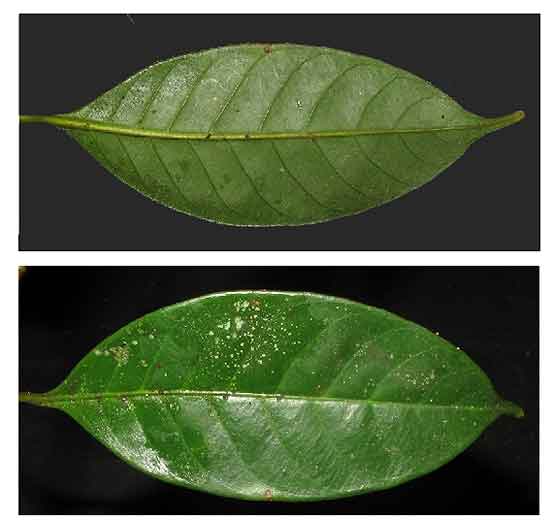 Gen info Gen info
- Kibatalia is a genus of trees and shrubs in the family Apocynaceae. It was first described as a genus in 1826. It was initially called Hasseltia, an illegitimate homonym, which was replaced by Kibatalia. It consists of 15 species. (8)
Botany
Kibatalia arborea is a big tree up to 45(-65) m tall. Leaves elliptical to obovate, 10-26(-35) cm × (5-)8-13 cm, with 15-60 colleters in the leaf axils. Inflorescence is 1-12-flowered, cymose cluster, sepals shortly united, with 70-100 colleters inside, corolla very variable, the lobes 0.2-2.2 times as long as the tube. Fruit consisting of 2 parallel-divergent mericarps, mericarp very narrowly ellipsoid to very narrowly clavate, 25-35 cm × 1-2.5 cm. (2)
Kibatalia arborea is a tree that grows to a height of 36m with a girth of 2.7m. Crown is small. Bole is straight and nonbuttressed. Bark is grayish-black and smooth. Inner bark is granular, white and orange, and with a milky latex which can be used to make rubber. Stems are thick, fissured, lenticelled, articulated, and measuring up to 8mm in diameter. Leaves are simple, decussate, and exstipulate. Petiole is about 1cm long and channeled above. Blade is ovate, elliptical, 20cm × 10cm, and showing 6–10 pairs of secondary nerves visible below only. Fruits are impressively massive, woody, up to 80cm- long pairs of follicles containing several linear hairy seeds up to 15cm long. (7)
 Distribution Distribution
- Native to the Philippines.
- Also native to Borneo, Jawa, Malaya, Sulawesi, Sumatera, Thailand.
- In lowland forests, on stream banks and steep slopes, from sea level to 500 meters altitude.
Constituents
- In a study for steroidal alkaloids from the Apocynaceae family, K. arborea yielded holafebrine. (5)
- Phytochemical screening yielded flavonoid, kuinon, tannin, polyphenol, saponin, alkaloid, and triterpenoid, with absence of steroid.
(6)
Properties
- Studies have suggested antimalarial, anticancer properties.
Parts used
Bark, latex.
Uses
Edibility
- Flowers can be cooked and eaten.
Folkloric
- In traditional medicine, used for the treatment of internal parasites.
- Latex used for treatment of stomach disorders.
- In Java, a few drops of latex in water drunk as anthelmintic, but may cause inflammation. (2)
Others
- Craft: In southwest Sulawesi, wood used for making sabre sheaths. Elsewhere, used for making household items.
Studies
• Anticancer / Bark: Study evaluated 23 species of Indonesian plants by mechanism-based yeast bioassay for anticancer activity. Six of 23 species of Apocynaceae, Simaroubaceae and Magnoliaceae showed potential as anticancer agents, as DNA damaging agent or Topoisomerase inhibitor. The best anticancer extracts were bark extracts of Funtumia elastic, Kibatalia arborea, and Michelia champaca that showed bioactivity on Saccharomyces cereviceae strain 1140 (Topoisomerase I inhibitor) with IC12 values at 1590.78, 1657.67, 3424.54 µg/mL, respectively and bioactivity on Saccharomyces cereviceae strain 1353 (Topoisomerase II inhibitor) with IC12 values at 353.42, 931.39, 2124.42 µg/mL, respectively. Camptothecin and Nystatin were used as reference anticancer and antifungal agent. (3)
• Antimalarial / Bark: Study evaluated the antimalarial activity of crude methanolic extracts of Kibatalia arborea leaves and Swietenia mahagoni seeds using an invitro antimalarial assay against Plasmodium falcifarum. Kibatalia arborea showed significant antiplasmodial activity against Plasmodium flaciparum 3D7 with IC50 of 12.37 µg/mL. (4)
• Phytochemical and Cytotoxicity Study / Bark: Brine shrimp lethality bioassay is a simple, cheap, and fast test for toxic compounds from natural products. LC50 values greater than 1000 ppm for plant extracts are considered inactive. In cytotoxicity testing using brine shrimp lethality, Kibatalia arborea showed an LC50 > 1000 µg/mL. (see constituents above) (6)
Availability
Wild-crafted. |

![]()





